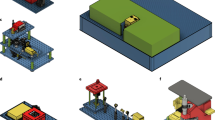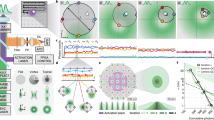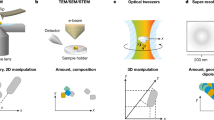Abstract
We review the use of luminescent nanoparticles in super-resolution imaging and single-molecule tracking, and showcase novel approaches to super-resolution imaging that leverage the brightness, stability, and unique optical-switching properties of these nanoparticles. We also discuss the challenges associated with their use in biological systems, including intracellular delivery and molecular targeting. In doing so, we hope to provide practical guidance for biologists and continue to bridge the fields of super-resolution imaging and nanoparticle engineering to support their mutual advancement.
This is a preview of subscription content, access via your institution
Access options
Access Nature and 54 other Nature Portfolio journals
Get Nature+, our best-value online-access subscription
$29.99 / 30 days
cancel any time
Subscribe to this journal
Receive 12 print issues and online access
$259.00 per year
only $21.58 per issue
Buy this article
- Purchase on Springer Link
- Instant access to full article PDF
Prices may be subject to local taxes which are calculated during checkout




Similar content being viewed by others
References
Resch-Genger, U., Grabolle, M., Cavaliere-Jaricot, S., Nitschke, R. & Nann, T. Quantum dots versus organic dyes as fluorescent labels. Nat. Methods 5, 763–775 (2008).
Yang, X. et al. Versatile application of fluorescent quantum dot labels in super-resolution fluorescence microscopy. ACS Photonics 3, 1611–1618 (2016). This paper provides an overview of practical examples of the use of commercial quantum dots in a variety of super-resolution microscopy systems widely accessible to biological labs.
Hanne, J. et al. STED nanoscopy with fluorescent quantum dots. Nat. Commun. 6, 7127 (2015).
Dertinger, T., Colyer, R., Iyer, G., Weiss, S. & Enderlein, J. Fast, background-free, 3D super-resolution optical fluctuation imaging (SOFI). Proc. Natl. Acad. Sci. USA 106, 22287–22292 (2009). This paper resports a high-contrast super-resolution method (SOFI) for imaging quantum-dot-labeled microtubules of fibroblast cells.
Zeng, Z. et al. Fast super-resolution imaging with ultra-high labeling density achieved by joint tagging super-resolution optical fluctuation imaging. Sci. Rep 5, 8359 (2015).
Chen, X., Zeng, Z., Wang, H. & Xi, P. Three dimensional multimodal sub-diffraction imaging with spinning-disk confocal microscopy using blinking/fluctuation probes. Nano Res. 8, 2251–2260 (2015).
Zhou, B., Shi, B., Jin, D. & Liu, X. Controlling upconversion nanocrystals for emerging applications. Nat. Nanotechnol. 10, 924–936 (2015).
Fan, W., Bu, W. & Shi, J. On the latest three-stage development of nanomedicines based on upconversion nanoparticles. Adv. Mater. 28, 3977–4011 (2016).
Chen, G., Qiu, H., Prasad, P. N. & Chen, X. Upconversion nanoparticles: design, nanochemistry, and applications in theranostics. Chem. Rev. 114, 5161–5214 (2014).
Zhao, J. et al. Single-nanocrystal sensitivity achieved by enhanced upconversion luminescence. Nat. Nanotechnol. 8, 729–734 (2013).
Gargas, D. J. et al. Engineering bright sub-10-nm upconverting nanocrystals for single-molecule imaging. Nat. Nanotechnol. 9, 300–305 (2014).
Liu, Y. et al. Amplified stimulated emission in upconversion nanoparticles for super-resolution nanoscopy. Nature 543, 229–233 (2017). This paper describes highly doped upconversion nanoparticles suitable for low-power, high-contrast super-resolution microscopy with optical resolution 1/36 of the excitation wavelength.
Zhan, Q. et al. Achieving high-efficiency emission depletion nanoscopy by employing cross relaxation in upconversion nanoparticles. Nat. Commun. 8, 1058 (2017).
Wang, B. et al. A mitochondria-targeted fluorescent probe based on TPP-conjugated carbon dots for both one- and two-photon fluorescence cell imaging. RSC Advances 4, 49960–49963 (2014).
Leménager, G., De Luca, E., Sun, Y.-P. & Pompa, P. P. Super-resolution fluorescence imaging of biocompatible carbon dots. Nanoscale 6, 8617–8623 (2014). This paper reports STED super-resolution microscopy using biocompatible CDots in both fixed and living cells.
Chizhik, A. M. et al. Super-resolution optical fluctuation bio-imaging with dual-color carbon nanodots. Nano Lett. 16, 237–242 (2016).
Khan, S., Verma, N. C., Gupta, A. & Nandi, C. K. Reversible photoswitching of carbon dots. Sci. Rep. 5, 11423 (2015).
He, H. et al. High-density super-resolution localization imaging with blinking carbon dots. Anal. Chem. 89, 11831–11838 (2017). This paper systematically compares the performance of CDots and Cy3, Cy5, Alexa Fluor 647, and QDots 605, and shows that the stable blinking of CDots is suitable for high-density localization imaging of microtubules and membrane protein receptors.
Wu, C. et al. Bioconjugation of ultrabright semiconducting polymer dots for specific cellular targeting. J. Am. Chem. Soc. 132, 15410–15417 (2010).This paper reports surface-functionalized polymer dots for covalent conjugation to biomolecules, and systematically validates the exceptional brightness ofpolymer dots compared with that of Alexa Fluor dyes and quantum dot probes.
Chen, X. et al. Small photoblinking semiconductor polymer dots for fluorescence nanoscopy. Adv. Mater. 29, 1604850 (2017).
Fang, X. et al. Multicolor photo-crosslinkable AIEgens toward compact nanodots for subcellular imaging and STED nanoscopy. Small 13, 1702128 (2017).
Li, D., Qin, W., Xu, B., Qian, J. & Tang, B. Z. AIE nanoparticles with high stimulated emission depletion efficiency and photobleaching resistance for long-term super-resolution bioimaging. Adv. Mater. 29, 1703643 (2017).
Dahan, M. et al. Diffusion dynamics of glycine receptors revealed by single-quantum dot tracking. Science 302, 442–445 (2003).
Lowe, A. R. et al. Selectivity mechanism of the nuclear pore complex characterized by single cargo tracking. Nature 467, 600–603 (2010). This paper systematically studies how the nuclear pore complex facilitates the translocation of transport cargo complexes by tracking a large number of single protein-functionalized quantum dots.
Cui, B. et al. One at a time, live tracking of NGF axonal transport using quantum dots. Proc. Natl. Acad. Sci. USA 104, 13666–13671 (2007).
Chowdary, P. D. et al. Nanoparticle-assisted optical tethering of endosomes reveals the cooperative function of dyneins in retrograde axonal transport. Sci. Rep. 5, 18059 (2015).
Warshaw, D. M. et al. Differential labeling of myosin V heads with quantum dots allows direct visualization of hand-over-hand processivity. Biophys. J. 88, L30–L32 (2005).
Yu, J. et al. Nanoscale 3D tracking with conjugated polymer nanoparticles. J. Am. Chem. Soc. 131, 18410–18414 (2009).
Chang, Y.-R. et al. Mass production and dynamic imaging of fluorescent nanodiamonds. Nat. Nanotechnol. 3, 284–288 (2008).
Haziza, S. et al. Fluorescent nanodiamond tracking reveals intraneuronal transport abnormalities induced by brain-disease-related genetic risk factors. Nat. Nanotechnol. 12, 322–328 (2017).
Tzeng, Y. K. et al. Superresolution imaging of albumin-conjugated fluorescent nanodiamonds in cells by stimulated emission depletion. Angew. Chem. Int. Ed. Engl. 50, 2262–2265 (2011). This paper demonstrates STED super-resolution imaging of single photostable fluorescent nanodiamonds in cells.
Bae, Y. M. et al. Endocytosis, intracellular transport, and exocytosis of lanthanide-doped upconverting nanoparticles in single living cells. Biomaterials 33, 9080–9086 (2012).
Nam, S. H. et al. Long-term real-time tracking of lanthanide ion doped upconverting nanoparticles in living cells. Angew. Chem. 123, 6217–6221 (2011). This paper reports real-time tracking of near-infrared excited photostable upconverting nanoparticles in living cells for as long as 6 h.
Jo, H. L. et al. Fast and background-free three-dimensional (3D) live-cell imaging with lanthanide-doped upconverting nanoparticles. Nanoscale 7, 19397–19402 (2015).
Liu, M. et al. Real-time visualization of clustering and intracellular transport of gold nanoparticles by correlative imaging. Nat. Commun. 8, 15646 (2017).
Tracking nanoparticles by eye. Nat. Methods 15, 164 (2018).
Wang, F. et al. Microscopic inspection and tracking of single upconversion nanoparticles in living cells. Light Sci. Appl. 7, 18007 (2018). This paper shows that single upconversion nanoparticles are very bright, stable and bleach resistant, and can be detected within cells by eye through the microscope eyepiece, thus providing a new tool for tracking experiments.
Sedlmeier, A. & Gorris, H. H. Surface modification and characterization of photon-upconverting nanoparticles for bioanalytical applications. Chem. Soc. Rev. 44, 1526–1560 (2015).
Wegner, K. D. & Hildebrandt, N. Quantum dots: bright and versatile in vitro and in vivo fluorescence imaging biosensors. Chem. Soc. Rev. 44, 4792–4834 (2015).
Derfus, A. M., Chan, W. C. & Bhatia, S. N. Intracellular delivery of quantum dots for live cell labeling and organelle tracking. Adv. Mater. 16, 961–966 (2004).
Delehanty, J. B., Mattoussi, H. & Medintz, I. L. Delivering quantum dots into cells: strategies, progress and remaining issues. Anal. Bioanal. Chem. 393, 1091–1105 (2009).
Courty, S., Luccardini, C., Bellaiche, Y., Cappello, G. & Dahan, M. Tracking individual kinesin motors in living cells using single quantum-dot imaging. Nano Lett. 6, 1491–1495 (2006).
Sun, Y. et al. A supramolecular self-assembly strategy for upconversion nanoparticle bioconjugation. Chem. Commun. (Camb.) 54, 3851–3854 (2018).
Drees, C. et al. Engineered upconversion nanoparticles for resolving protein interactions inside living cells. Angew. Chem. Int. Ed. Engl. 55, 11668–11672 (2016).
Jung, Y. K., Shin, E. & Kim, B.-S. Cell nucleus-targeting zwitterionic carbon dots. Sci. Rep. 5, 18807 (2015).
Wu, L., Li, X., Ling, Y., Huang, C. & Jia, N. Morpholine derivative-functionalized carbon dots-based fluorescent probe for highly selective lysosomal imaging in living cells. ACS Appl. Mater. Interfaces 9, 28222–28232 (2017).
Pinaud, F., King, D., Moore, H.-P. & Weiss, S. Bioactivation and cell targeting of semiconductor CdSe/ZnS nanocrystals with phytochelatin-related peptides. J. Am. Chem. Soc. 126, 6115–6123 (2004).
Navas-Moreno, M. et al. Nanoparticles for live cell microscopy: a surface-enhanced Raman scattering perspective. Sci. Rep. 7, 4471 (2017).
Wildanger, D. et al. Solid immersion facilitates fluorescence microscopy with nanometer resolution and sub-ångström emitter localization. Adv. Mater. 24, OP309–OP313 (2012).
Han, K. Y., Kim, S. K., Eggeling, C. & Hell, S. W. Metastable dark states enable ground state depletion microscopy of nitrogen vacancy centers in diamond with diffraction-unlimited resolution. Nano Lett. 10, 3199–3203 (2010).
Chen, X. et al. Subdiffraction optical manipulation of the charge state of nitrogen vacancy center in diamond. Light Sci. Appl. 4, e230 (2015).
Han, K. Y. et al. Three-dimensional stimulated emission depletion microscopy of nitrogen-vacancy centers in diamond using continuous-wave light. Nano Lett. 9, 3323–3329 (2009).
Yang, X. et al. Sub-diffraction imaging of nitrogen-vacancy centers in diamond by stimulated emission depletion and structured illumination. RSC Advances 4, 11305–11310 (2014).
Chen, E. H., Gaathon, O., Trusheim, M. E. & Englund, D. Wide-field multispectral super-resolution imaging using spin-dependent fluorescence in nanodiamonds. Nano Lett. 13, 2073–2077 (2013).
Yahiatene, I., Hennig, S., Müller, M. & Huser, T. Entropy-based super-resolution imaging (ESI): from disorder to fine detail. ACS Photonics 2, 1049–1056 (2015).
Mandula, O., Šestak, I. Š., Heintzmann, R. & Williams, C. K. Localisation microscopy with quantum dots using non-negative matrix factorisation. Opt. Express 22, 24594–24605 (2014).
Cox, S. et al. Bayesian localization microscopy reveals nanoscale podosome dynamics. Nat. Methods 9, 195–200 (2011).
Hennig, S., Mönkemöller, V., Böger, C., Müller, M. & Huser, T. Nanoparticles as nonfluorescent analogues of fluorophores for optical nanoscopy. ACS Nano 9, 6196–6205 (2015).
Ando, J., Fujita, K., Smith, N. I. & Kawata, S. Dynamic SERS imaging of cellular transport pathways with endocytosed gold nanoparticles. Nano Lett. 11, 5344–5348 (2011).
Yang, B., Przybilla, F., Mestre, M., Trebbia, J.-B. & Lounis, B. Large parallelization of STED nanoscopy using optical lattices. Opt. Express 22, 5581–5589 (2014).
Rego, E. H. et al. Nonlinear structured-illumination microscopy with a photoswitchable protein reveals cellular structures at 50-nm resolution. Proc. Natl. Acad. Sci. USA 109, E135–E143 (2012).
Chmyrov, A. et al. Nanoscopy with more than 100,000 ‘doughnuts’. Nat. Methods 10, 737–740 (2013).
Zhanghao, K. et al. Super-resolution with dipole orientation mapping via polarization demodulation. Light Sci. Appl. 5, e16166 (2016).
Hafi, N. et al. Fluorescence nanoscopy by polarization modulation and polarization angle narrowing. Nat. Methods 11, 579–584 (2014).
Rittweger, E., Han, K., Irvine, S., Eggeling, C. & Hell, S. STED microscopy reveals crystal colour centres with nanometric resolution. Nat. Photonics 3, 144–147 (2009).
Balzarotti, F. et al. Nanometer resolution imaging and tracking of fluorescent molecules with minimal photon fluxes. Science 355, 606–612 (2017).
Yu, J., Xiao, J., Ren, X., Lao, K. & Xie, X. S. Probing gene expression in live cells, one protein molecule at a time. Science 311, 1600–1603 (2006).
Park, H. Y. et al. Visualization of dynamics of single endogenous mRNA labeled in live mouse. Science 343, 422–424 (2014).
Lubeck, E. & Cai, L. Single-cell systems biology by super-resolution imaging and combinatorial labeling. Nat. Methods 9, 743–748 (2012).
Chen, K. H., Boettiger, A. N., Moffitt, J. R., Wang, S. & Zhuang, X. Spatially resolved, highly multiplexed RNA profiling in single cells. Science 348, aaa6090 (2015).
Lu, Y. et al. Tunable lifetime multiplexing using luminescent nanocrystals. Nat. Photonics 8, 32–36 (2014).
Dong, H. et al. Versatile spectral and lifetime multiplexing nanoplatform with excitation orthogonalized upconversion luminescence. ACS Nano 11, 3289–3297 (2017).
Lin, G., Baker, M. A. B., Hong, M. & Jin, D. The quest for optical multiplexing in bio-discoveries. Chem 4, 997–1021 (2018).
Liu, D. et al. Three-dimensional controlled growth of monodisperse sub-50 nm heterogeneous nanocrystals. Nat. Commun. 7, 10254 (2016).
O’Neill, J. Rapid Diagnostics: Stopping Unnecessary Use of Antibiotics (Review on Antimicrobial Resistance, London, 2015).
Plochowietz, A., Crawford, R. & Kapanidis, A. N. Characterization of organic fluorophores for in vivo FRET studies based on electroporated molecules. Phys. Chem. Chem. Phys. 16, 12688–12694 (2014).
van Oijen, A. M. & Dixon, N. E. Probing molecular choreography through single-molecule biochemistry. Nat. Struct. Mol. Biol. 22, 948–952 (2015).
Gooding, J. J. & Gaus, K. Single-molecule sensors: challenges and opportunities for quantitative analysis. Angew. Chem. Int. Ed. Engl. 55, 11354–11366 (2016).
Hoyer, P., Staudt, T., Engelhardt, J. & Hell, S. W. Quantum dot blueing and blinking enables fluorescence nanoscopy. Nano Lett. 11, 245–250 (2011).
Xu, J., Tehrani, K. F. & Kner, P. Multicolor 3D super-resolution imaging by quantum dot stochastic optical reconstruction microscopy. ACS Nano 9, 2917–2925 (2015).
Chen, X. et al. Multicolor super-resolution fluorescence microscopy with blue and carmine small photoblinking polymer dots. ACS Nano 11, 8084–8091 (2017).
McGuinness, L. P. et al. Quantum measurement and orientation tracking of fluorescent nanodiamonds inside living cells. Nat. Nanotechnol. 6, 358–363 (2011).
Leduc, C. et al. A highly specific gold nanoprobe for live-cell single-molecule imaging. Nano Lett. 13, 1489–1494 (2013).
Wu, C. et al. Ultrabright and bioorthogonal labeling of cellular targets using semiconducting polymer dots and click chemistry. Angew. Chem. Int. Ed. Engl. 49, 9436–9440 (2010).
Irvine, S. E., Staudt, T., Rittweger, E., Engelhardt, J. & Hell, S. W. Direct light-driven modulation of luminescence from Mn-doped ZnSe quantum dots. Angew. Chem. Int. Ed. Engl. 47, 2685–2688 (2008).
Kolesov, R. et al. Super-resolution upconversion microscopy of praseodymium-doped yttrium aluminum garnet nanoparticles. Phys. Rev. B 84, 153413 (2011).
Cutler, P. J. et al. Multi-color quantum dot tracking using a high-speed hyperspectral line-scanning microscope. PLoS One 8, e64320 (2013).
Keller, A. M. et al. 3-dimensional tracking of non-blinking ‘giant’ quantum dots in live cells. Adv. Funct. Mater. 24, 4796–4803 (2014).
Hatakeyama, H., Nakahata, Y., Yarimizu, H. & Kanzaki, M. Live-cell single-molecule labeling and analysis of myosin motors with quantum dots. Mol. Biol. Cell 28, 173–181 (2017).
Acknowledgements
The authors acknowledge S. Qu (Changchun Institute of Optics Fine Mechanics and Physics, Chinese Academy of Sciences), C. Wu (Southern University of Science and Technology), Q. Su, O. Shimoni, and F. Wang for valuable technical discussions. D.J., A.M.v.O., and P.X. acknowledge support from the Australian Research Council (FT 130100517, FL140100027) and the National Natural Science Foundation of China (61729501, 51720105015). J.E. is grateful for financial support from the Cluster of Excellence and DFG Research Centre Nanoscale Microscopy and Molecular Physiology of the Brain (CNMPB).
Author information
Authors and Affiliations
Corresponding authors
Ethics declarations
Competing interests
The authors declare no competing interests.
Additional information
Publisher’s note: Springer Nature remains neutral with regard to jurisdictional claims in published maps and institutional affiliations.
Rights and permissions
About this article
Cite this article
Jin, D., Xi, P., Wang, B. et al. Nanoparticles for super-resolution microscopy and single-molecule tracking. Nat Methods 15, 415–423 (2018). https://doi.org/10.1038/s41592-018-0012-4
Received:
Accepted:
Published:
Issue Date:
DOI: https://doi.org/10.1038/s41592-018-0012-4
This article is cited by
-
A systematic study on the use of multifunctional nanodiamonds for neuritogenesis and super-resolution imaging
Biomaterials Research (2023)
-
InP colloidal quantum dots for visible and near-infrared photonics
Nature Reviews Materials (2023)
-
Line Verification in Luminescence Spectra of Fluorophosphate Glass Doped with Ytterbium and Thulium Ions by the Degree of Nonlinearity of Up-Conversion Processes
Journal of Applied Spectroscopy (2023)
-
Review on polymer degradation by selective solar concentration using up-conversion nanoparticles
Journal of Polymer Research (2023)
-
Rare nanoparticles shine colors with low-power STED
Light: Science & Applications (2022)



